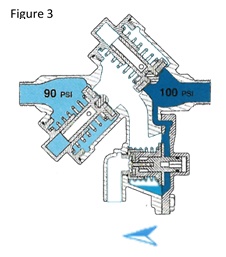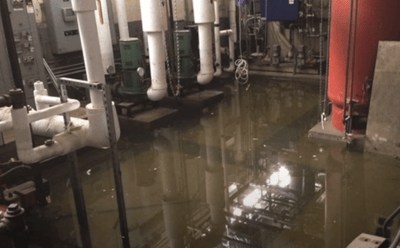Reduced Pressure Zone Assemblies (RPZs) are designed for use in commercial/industrial buildings to prevent contaminated water from mixing into clean municipal water supplies. Contaminants like sediments, bacteria and fertilizer are a major public health hazard, so there are regulations in place to have backflow preventers installed. However, there are disagreements to where these important devices should be installed to allow for proper maintenance and service. But to determine this, let’s discuss first how they work, and then, the issues they may cause should they fail.
How RPZ Backflows Function
 A RPZ consists of two independently operating check valves just like the double-check as well as a hydraulically-operated differential relief valve located below the first check valve.
A RPZ consists of two independently operating check valves just like the double-check as well as a hydraulically-operated differential relief valve located below the first check valve.
Both hydraulic valve and its placement makes the RPZ virtually fail-safe, but it can cause a major issue that is often overlooked.
When a flow stop occurs, both check valves close. At that moment, the relief valve opens and evacuates the water between the valves. (Figure 3) Some think that this event defines the limit of how much water can flow from the relief valve, however, the amount of water can be tremendous if this relief valve fails or is stuck in open position.
How RPZ Backflows are Typically Installed
As mentioned above, an RPZ can keep contaminants out of the buildings drinking supply, but must discharge water when dealing with a flow stop. During this moment, the RPZ discharges an amount of water to regulate the pressure in the zone.
Typically, engineers specify RPZs being installed in mechanical rooms, located above small drains. The problem is that the drains are just too small to evacuate as much water as is necessary, especially for larger devices. In order to properly dispel all that water, you'd need either multiple drains, or very large one(s).
This logic is not only flawed, the proper drainage solution also comes with another problem - cost. Chicago ASPE Chapter member David DeBord said in a 2013 article that “[t]he floor drain capacity required for RPZs 3-inches diameter and larger are likely to be cost-prohibitive due to necessary pipe diameter and fall rates.”
The Problem with Installing RPZ Backflows Inside
 The most important thing a designer must understand is the worst case scenario. What can happen? What describes the ‘perfect storm'? Many believe that small discharges define the maximum amount of water that will ever flow through the relief valve. But that simply isn't the case.
The most important thing a designer must understand is the worst case scenario. What can happen? What describes the ‘perfect storm'? Many believe that small discharges define the maximum amount of water that will ever flow through the relief valve. But that simply isn't the case.
If the 2nd check valve is not closing due to debris or failure, all the water delivered to the building will continue to flow through the relief valve until all the lines are cleared. If this is a four-story building or 104 story building, that’s a lot of water!
This creates the conditions for the ‘perfect storm’ scenario. Under such conditions, a constant flow of delivered water will begin to flow directly through the relief valve.
This creates the conditions for the ‘perfect storm’ scenario. Under such conditions, a constant flow of water will begin to flow directly through the relief valve. Thousands and thousands of gallons of water will be discharged into the mechanical room of your facility. This is the perfect storm, and it happens more frequently than you can imagine.
Watch this video to learn more about what happens when an RPZ starts discharging water.
Keep RPZ Backflows Outside and Safe
There are only a few reasons why anyone might want to install a backflow prevention assembly in a mechanical room. They’re either trying to protect it from the weather, keep it from being vandalized or for aesthetic purposes. But the USC Foundation recommends all assemblies be installed above grade. If you’re concerned about safety, there’s only one place to install your RPZ: in an RPZ enclosure that is outside the building.
Keep your RPZs out of your facilities and out of the mechanical engineer's domain. Encourage your local water district or engineers to locate RPZs outdoors and keep them safe in a properly insulated enclosure. To learn more about what size enclosure you might need, consult our “How To Buy” guide.




